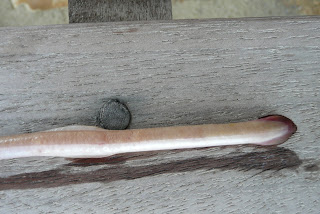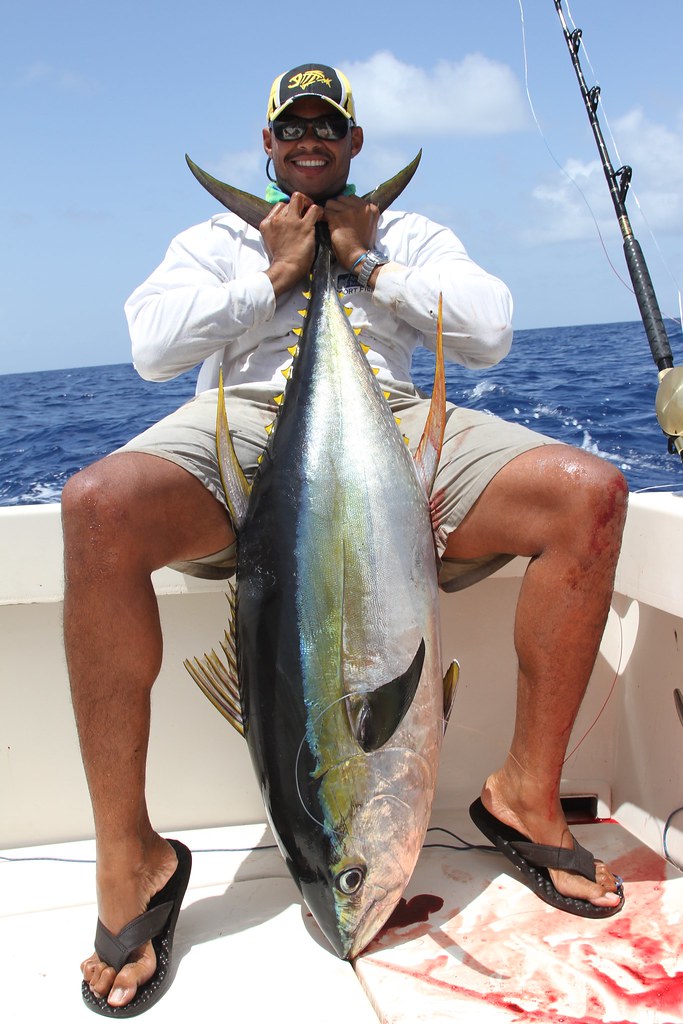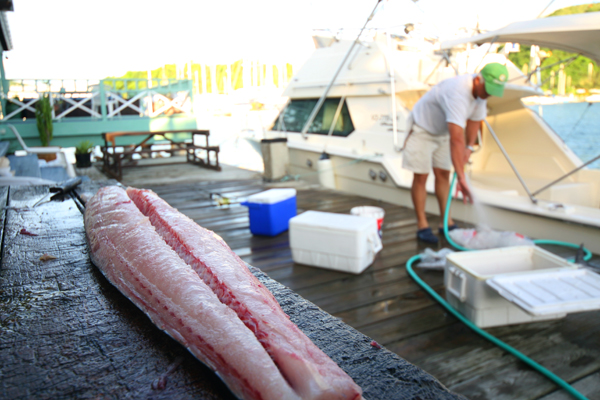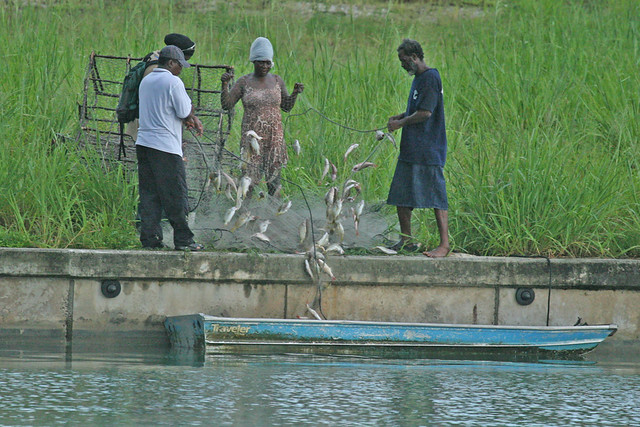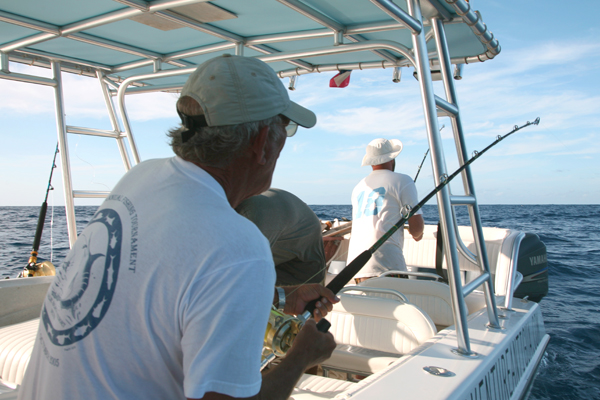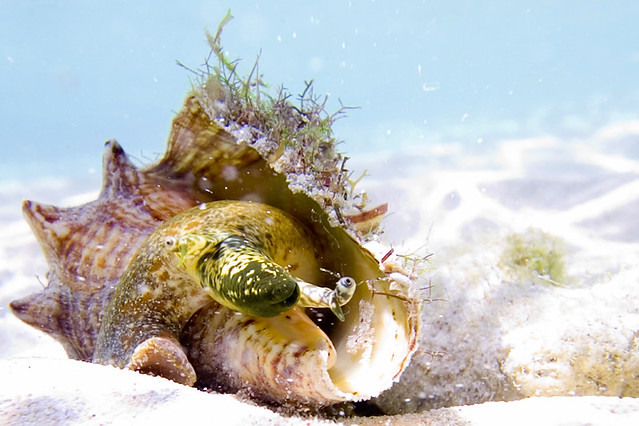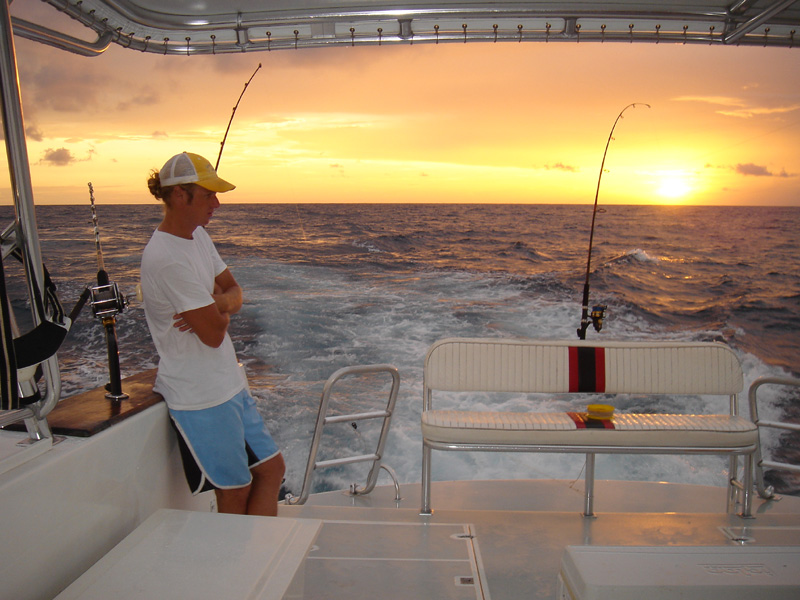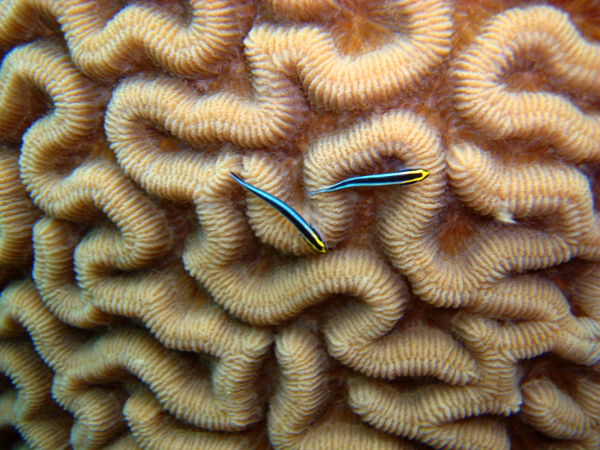Before I explain what happened yesterday I want to point the readers attention to several blogs I have written about the ongoing problem of French commercial fishing in our waters. Specifically on FADs. I have been speaking and writing about this for years and Antigua's deep sea fishermen have been complaining to the authorities for considerably longer.
Click here and click here for info on the problem of St. Barts and Guadeloupe's commercial fishing industry in our waters (includes video and photos).
Recently during an Antigua Sport Fishing Association tournament we met some commercial fishermen from St. Barts who owned FADS that we had found 12 miles off Barbuda's north coast. They explained to us that they were not doing anything illegal because they were permitted to fish in "International Waters" and that their DCP's, as they call FADs, were anchored 12 miles off. Their argument rested on what is known all around the world as Territorial vs. International Waters. Here is a very good definition of Territorial Waters and I think the problem is that the French Government is not telling their commerical fishermen the difference between Territorial Zones and Exclusive Economic Zones. It seems as though commercial fishermen from St. Barts and Guadeloupe either don't know about Exclusive Economic Zones or know that our Government doesn't care if they fish illegally in our waters. Here is a good definition of the Exclusive Economic Zone. Remember the zone is calculated around Antigua Barbuda and Redonda going out 200 miles unless it borders with another country's EEZ. This very crude drawing below done by me gives a very very very rough estimate of what our Exclusive Economic Zone could look like.
(edit: I just found an actual map of Antigua and Barbuda's EEZ which is very close to my guestimate: Click Here)
I am sure that our Fisheries Department has a proper map but generally this area which starts along the triangular borders of Antigua Barbuda and Redonda is quite unique in its size. We are blessed to have so much of it but we are permitting the French to use it for the betterment of their economy while ours declines.
Anyway, yesterday we went looking for tuna twenty five miles East North East of Antigua and found a French FAD. There are many up there and you just have to either look for big flocks of birds or find small French fishing boats and you will then find FADS. We found a FAD in our waters and started fishing. Shortly afterwards we spotted a boat on the horizon coming in from the North East (deeper into our Economic Zone). The boat was about 34 feet long and had twin 300hp Suzuki engines and two fishermen on board. The PP registration numbers told of a Guadeloupe registration. In a very threatening maneuver it raced full speed towards us as if on a collision course. We had our engines off and had three lines in the water and had to scramble to start engines and move just as the other boat slowed just feet from our windward port side. We believe they intended to run over our lines thinking we were fishing using a similar method that they use. We were not and our lines were not cut. Anyway, they started yelling and screaming at us. I maneuvered my boat so that I could better defend myself if need be and tried to explain that they were fishing illegally in our waters and that I was calling the coast guard. Of course, our VHF radio couldn't make contact with Antigua's coast guard probably because of the distance from shore. They kept on yelling and screaming at us out in the open ocean 25 miles from land where there was no one to witness what would happen if things got physical. One of our crew reminded us that many of these commercial guys carry guns and that guns are even more easy to find in GP than they are here in Antigua. We had one crew who understood some French and explained that they were saying that they were much further than 12 miles off Antigua and well within their rights to fish in these waters.
In the end I decided that this wasn't my battle to win or lose on this day and we retreated to another location taking these images as we left.
On the way to another fishing ground we spotted another even smaller Guadeloupean fishing boat drifting in the distance some 8 miles further east. We knew he would be fishing on a FAD and marked a course to intercept. As he spotted us coming he quickly moved away hoping we would not find his FAD. It was too late and we went over to it saving the GPS numbers to fish it at another time when they were not around. They didn't bother us as we didn't stop. We didn't want another fight out there at sea, so took some photos and moved on.
We continued another three miles to the north and found another FAD which we had seen a few months before. We fished there for a few hours and then passed the other two FADs on the way in. We spotted one other boat in the afternoon which to me was clearly was a different one than the other two.
By the end of the day we had caught over 300 lbs of fish using rods only.
On the way back to Antigua we saw Antiguan boats of similar sizes. One which was bigger than any of the French boats was pulling fish traps not too far east of Bird Island. Another not too far away was "hand lining" for snapper and hinds in about 150 feet of water, and the third boat was setting a huge gill net just off bird island at an area where most of the excursion boats snorkel during the day.
We here in Antigua have got to wake up. We need some politicians with guts and the gumption to do something about Antigua's fishery. We are sucking our reef fish dry and letting foreign fishermen do the same to our off shore fishery. By the time our local fishermen figure out that they can make more money out to sea using the same boats they are using now, it will be fished out by Guadeloupean and St. Barts fishermen. I think if two or three of these boats are confiscated out there and their crews thrown in the slammer, the free for all mentality will change. One of these days an Antiguan boat is going to be sunk out there and we will never know what happened to it. When that happens I think the blood will be on the hands of the Antigua and Barbuda government who has been told about all of this and does nothing at all about it.
This is a blog set up by Eli Fuller (me) to help keep readers informed and to promote our little country to prospective guests. It's also to make sure that new info about our island is passed on quickly and also to receive feedback on this info. Of course most of the things i write about have themes of ecology and usually have quite a bit to do with my company Adventure Antigua. Make comments anytime you want, but check the site above to book your adventure.
Tuesday, August 30, 2011
Saturday, August 27, 2011
Caribbean Sargasso Sea Weed Mystery - Solved (sort of)
Thousands of people have been trying to figure out why this weed is coming ashore and where it's coming from. New evidence spotted on Thursday here in Antigua provides the smoking gun scientists have been looking for.
As mentioned in my Sargasso blog from a few weeks ago (click here), huge amounts of Sargasso weed have been coming ashore from one end of the Caribbean to the other. My sister in law, Tanya Clovis-Howie, who runs the SOS turtle project in Tobago was quoted in a recent article about the unusual sargasso situation here: “It is common for a pile of it to wash up once a year for a relatively short period, but we have never in recent memory had so much of it for so long and seen such huge mats or lines of it from the air.”
Here in Antigua we have no historical mention of the weed coming ashore in these quantities either. Of course it could have happened before but we can't find any evidence of this sort of thing ever happening. As mentioned in the blog, Sargassum supports a massive eco system of wild life both under the water and above, and we have seen many of these species out on the water and along the windward coasts as the weed comes ashore. While out snorkeling recently, our Eco Tour spotted Sea Horses and the Sargasso Fish among other interesting things. One of the many species found in the Sargasso Sea's sargassum is the European Eel. The scientific name of this eel is Anguilla Anguilla and for hundreds of years Europeans tried to figure out where the eels reproduced. Aristotle was the first scientist who studied them making the incorrect hypothesis that they originated from the soil. You see, only adult species of the eel were observed in their fresh water habitats within the rivers of Europe, and it wasn't until 1922 when a Danish professor found tiny eel larvae in the Sargasso Sea off Bermuda. For more on the history of this eel check this wiki. And for a more recent study on the amazing life cycle of these eels click here to view a BBC report.
Ever since sargasso weed started coming ashore this summer scientists have been trying to find this eel so that they could figure out where this weed was coming from. Aparently this eel doesn't live in the sargassum that is found in the Gulf of Mexico or in the sargassum that is found off the North East coast of Brazil. Anguilla Anguilla is only found in the Sargasso Sea north of the Caribbean and East of Bermuda. On thursday a friend of mine observed quite a few of these eels being captured by birds as they slithered through a fresh batch of sargassum that had drifted into Mamora Bay.
This was the "smoking gun" and many think proves where the weed originates. The Sargasso Sea is such an important and large eco system and we have no idea what all of this means for it. In fact, one of the many groups of marine animals that we worry about is turtles. We have had reports of young turtles being washed ashore within the weed too. Of course we know that after turtle hatchlings make it to the sea, they try to get into currents which will help to steer them North towards the Sargasso Sea which is where they live for a few years. This photo was taken by my friends Perri and Mark Nyquist way out to sea off Florida:
It sounds like instead of spending two years feeding and hiding in the Sargasso Sea, many are finding themselves off course back here in the Caribbean. We have no real clue about what all of this means for this habitat and all the life cycles that it supports.
I recently was lucky enough to speak with David Freestone who is one of the world's most famous environmental lawyers and now chairman of the Sargasso Sea Alliance. His organization is trying to get international support for the creation of The Sargassso Sea as Marine Protected Area. This is easier said than done as the area floats in the open ocean without "belonging" to any particular country. Read more about the Alliance here. Mr. Freestone was here on holiday taking time off from his duties at the Alliance!! The irony is just amazing! Anyway, he felt as did many of the experts that this weed was originating from Brazil but said that if we found the European Eel then we would know for sure that the weed was from the Sargasso Sea. In a recent paper by Jim Gower, Erika Young and Stephanie King of Institute of Ocean Sciences (IOS) Canada, very good evidence was given suggesting that all of this weed originated off Brazil. Some of this evidence came in the form of various satellite images, but they did mention that they couldn't definitively prove it was from Brazil. I am interested to hear what they all say now that we have photos of the Anguilla Anguilla.
Whatever happens, the story is a dynamic one and this historical event is still developing. It will be some time before we know what it all means and why it happened. I am sure however, as i mentioned in my last blog on the issue, that what triggered the event we are now seeing here was the strange south currents we saw in May and June. What caused them is another story!
EDIT: Reports just relayed from the Sargasso Sea Alliance show massive amounts of weed floating up on the (West African) Sierra Leone coast too. This seems to be something totally usual too and people are also scratching their heads there too. Here is a photo that I received today:
As a side note, the beautiful St. James Club resort made the terribly saddening decision to close the hotel for a month on the same day the eel was found. It wasn't because of the eel but because of the smell of the rotting weed. Hydrogen Sulphide is released when the weed rots in the water and the smell is terrible. Just by chance Hurricane Irene was passing Antigua before it became a hurricane and caused a change in wind direction. This made what was normally the protected harbour of Mamora Bay a on shore deposit spot for a massive amount of weed. These dramatic photos taken by my friend Max Freeling during the passage of Irene show what we are speaking about:
As you can see, this was nothing like any of us had seen before or could possibly prepare for. There was no warning and while it seems as though the weed arrivals are slowing down, the hotel will remain closed for a month while it is all cleared up and the smell goes away. All other resorts on Antigua seem to have been spared and it's business as usual. In fact, guests from St. James Club are being sent to Verandah Resort and Spa and Galley Bay which are other Elite Island Resorts.
As mentioned in my Sargasso blog from a few weeks ago (click here), huge amounts of Sargasso weed have been coming ashore from one end of the Caribbean to the other. My sister in law, Tanya Clovis-Howie, who runs the SOS turtle project in Tobago was quoted in a recent article about the unusual sargasso situation here: “It is common for a pile of it to wash up once a year for a relatively short period, but we have never in recent memory had so much of it for so long and seen such huge mats or lines of it from the air.”
Here in Antigua we have no historical mention of the weed coming ashore in these quantities either. Of course it could have happened before but we can't find any evidence of this sort of thing ever happening. As mentioned in the blog, Sargassum supports a massive eco system of wild life both under the water and above, and we have seen many of these species out on the water and along the windward coasts as the weed comes ashore. While out snorkeling recently, our Eco Tour spotted Sea Horses and the Sargasso Fish among other interesting things. One of the many species found in the Sargasso Sea's sargassum is the European Eel. The scientific name of this eel is Anguilla Anguilla and for hundreds of years Europeans tried to figure out where the eels reproduced. Aristotle was the first scientist who studied them making the incorrect hypothesis that they originated from the soil. You see, only adult species of the eel were observed in their fresh water habitats within the rivers of Europe, and it wasn't until 1922 when a Danish professor found tiny eel larvae in the Sargasso Sea off Bermuda. For more on the history of this eel check this wiki. And for a more recent study on the amazing life cycle of these eels click here to view a BBC report.
Ever since sargasso weed started coming ashore this summer scientists have been trying to find this eel so that they could figure out where this weed was coming from. Aparently this eel doesn't live in the sargassum that is found in the Gulf of Mexico or in the sargassum that is found off the North East coast of Brazil. Anguilla Anguilla is only found in the Sargasso Sea north of the Caribbean and East of Bermuda. On thursday a friend of mine observed quite a few of these eels being captured by birds as they slithered through a fresh batch of sargassum that had drifted into Mamora Bay.
This was the "smoking gun" and many think proves where the weed originates. The Sargasso Sea is such an important and large eco system and we have no idea what all of this means for it. In fact, one of the many groups of marine animals that we worry about is turtles. We have had reports of young turtles being washed ashore within the weed too. Of course we know that after turtle hatchlings make it to the sea, they try to get into currents which will help to steer them North towards the Sargasso Sea which is where they live for a few years. This photo was taken by my friends Perri and Mark Nyquist way out to sea off Florida:
It sounds like instead of spending two years feeding and hiding in the Sargasso Sea, many are finding themselves off course back here in the Caribbean. We have no real clue about what all of this means for this habitat and all the life cycles that it supports.
I recently was lucky enough to speak with David Freestone who is one of the world's most famous environmental lawyers and now chairman of the Sargasso Sea Alliance. His organization is trying to get international support for the creation of The Sargassso Sea as Marine Protected Area. This is easier said than done as the area floats in the open ocean without "belonging" to any particular country. Read more about the Alliance here. Mr. Freestone was here on holiday taking time off from his duties at the Alliance!! The irony is just amazing! Anyway, he felt as did many of the experts that this weed was originating from Brazil but said that if we found the European Eel then we would know for sure that the weed was from the Sargasso Sea. In a recent paper by Jim Gower, Erika Young and Stephanie King of Institute of Ocean Sciences (IOS) Canada, very good evidence was given suggesting that all of this weed originated off Brazil. Some of this evidence came in the form of various satellite images, but they did mention that they couldn't definitively prove it was from Brazil. I am interested to hear what they all say now that we have photos of the Anguilla Anguilla.
Whatever happens, the story is a dynamic one and this historical event is still developing. It will be some time before we know what it all means and why it happened. I am sure however, as i mentioned in my last blog on the issue, that what triggered the event we are now seeing here was the strange south currents we saw in May and June. What caused them is another story!
EDIT: Reports just relayed from the Sargasso Sea Alliance show massive amounts of weed floating up on the (West African) Sierra Leone coast too. This seems to be something totally usual too and people are also scratching their heads there too. Here is a photo that I received today:
As a side note, the beautiful St. James Club resort made the terribly saddening decision to close the hotel for a month on the same day the eel was found. It wasn't because of the eel but because of the smell of the rotting weed. Hydrogen Sulphide is released when the weed rots in the water and the smell is terrible. Just by chance Hurricane Irene was passing Antigua before it became a hurricane and caused a change in wind direction. This made what was normally the protected harbour of Mamora Bay a on shore deposit spot for a massive amount of weed. These dramatic photos taken by my friend Max Freeling during the passage of Irene show what we are speaking about:
As you can see, this was nothing like any of us had seen before or could possibly prepare for. There was no warning and while it seems as though the weed arrivals are slowing down, the hotel will remain closed for a month while it is all cleared up and the smell goes away. All other resorts on Antigua seem to have been spared and it's business as usual. In fact, guests from St. James Club are being sent to Verandah Resort and Spa and Galley Bay which are other Elite Island Resorts.
Friday, August 26, 2011
Sustainable seafood - a look at eco friendly fish dinners.
This was taken from my column in Enjoy Magazine which comes out here in Antigua every two weeks. There are copies all over the island. ENJOY!
These days choosing what seafood you will order from the menu can have as much to do with your morals as your taste buds, and having good info about what's on offer will help you enjoy your meal that much more. I remember taking Environmental Science as an elective in University back in 1989 and hearing about why certain fish stocks had plummeted. It all had to do with supply and demand as is the case with most things i guess, but the main message was that historically, seafood was only eaten by people who lived close to the sea. Now with modern supply chains, refrigerated storage and other technological advances even people in Allen, South Dakota (1024 miles from the nearest shore) can have fresh seafood whenever they want. The demand outweighs the supply quite often.
There are many different types of seafood that you will find here on the menu in Antigua, some more "eco-friendly" or sustainable than others.
What makes a seafood sustainable? Seafood that is caught in a way that will not jeopardize the survival of the species or the eco system from where it is taken is considered sustainable, but there are other considerations that have to do with the ecological footprint of that seafood. The ecological footprint would partially have to do with whether the seafood was imported, how far it had to be shipped from, and the methods of harvesting. This is very hard to figure out for imported seafood as we don't usually have that information when it arrives in Antigua.
For people living in the USA there are some great guides on sustainable fish and seafood. There has been considerable research done on the status of different fish species and what harvesting methods should be used in order to catch that species sustainably. We here in the Caribbean can use some of this research to help us decide what to eat and what to avoid. The Environmental Defense Fund has a great seafood guide on the internet and there are even similar apps these days for your smart phone.
Mahi Mahi or Dolphin Fish above. Read more about them here.
Although imports such as salmon, US caught shrimp, and squid can be labeled eco friendly, I think that it's best to eat locally caught "pelagic" or open ocean species that reproduce quickly. Such species are Atlantic yellowfin tuna, blackfin tuna, wahoo, Dolphin Fish (a.k.a Mahi Mahi), Rainbow Runner, and some Mackerel species. While most of these fish are available here on the menu much of what you will find in restaurants is imported to meet demand.
If you really want to eat responsibly ask your chef where the fish comes from and ask if they know if the fish were caught by rod and reel. If these species were caught locally on rod and reel then the chances that there was by-catch is almost nil. One of the big problems with eating tuna these days is that most tuna is caught in nets or on long lines.
It's almost impossible to catch fish in nets without killing others species in the nets as "by-catch". Often this by-catch happens to be endangered animals. There is quite a big community of fishermen here in Antigua that catch pelagic fish with rod and reel and some restaurants try to purchase only from these fresh sources.
If you support these eateries then you will be helping the environment too.
It is the opinion of most local marine biologists and environmentalists here in Antigua that shelf and inshore fish are not currently being caught in a sustainable way. These species include all reef fish and could possibly include deep water snapper and grouper.
At the moment lobster and conch also commonly fall into the unsustainable category as there are no closed seasons and poorly monitored and enforced size limits. Their diminishing numbers attest to this.
Setting up well managed Marine Protected Areas (like the NEMMA that I have blogged about) as well as open and closed seasons with carefully managed size limits will help create sustainable fisheries and make some of the species mentioned above "eco friendly", but for now if you want sustainable seafood your best choice would be the pelagic species caught by rod and reel.
(edit: This blog was posted on the Sustain T&T facebook page. Click here) Someone then posted a link to a very good Trinidad and Tobago sustainable seafood paper. Click here for that one.)
Friday, August 19, 2011
Adventure Antigua's facebook page gets edited
Before facebook had "pages" for companies I set up an Adventure Antigua "group" which is where people shared photos comments and videos. Then one day I had a message from facebook saying that groups would be phased out and that if we wanted to have our company on facebook, then we needed to start a "page". We did that and you can get to it by clicking here
It should look something like this:
Anyway, I figured that we would then start to see people using that more than our facebook group which was still up. That happened but very slowly. There were several updates and messages from facebook and I sort of just ignored them. Anyway, yesterday I finally found out a few things about facebook pages. The first terrible thing I found out about their pages is that they can sometimes make the page limited to geographic locations. I don't know why or how but our Adventure Antigua facebook page wasn't being seen all over the world. I fixed that. Then I noticed that many people who I would have expected to be on there were not on there. Reason: Well it seems as though facebook only permits people who have proved to facebook that they are over 13 years old. In your profile your birth date visible to the general public or not must have a proper date of birth including the year which shows that you are over 13 otherwise you won't be able to see facebook "pages". If you are one of the many people on facebook that doesn't have a real date of birth then you are missing out on many "pages". If you would like to see regular photos from our tours, tag yourself if you were in one of them then you better have a date of birth in your profile. It's not my rules but it's the way FB wants things. Thanks for joining or facebook page. Look for regular photos from our tours.
It should look something like this:
Anyway, I figured that we would then start to see people using that more than our facebook group which was still up. That happened but very slowly. There were several updates and messages from facebook and I sort of just ignored them. Anyway, yesterday I finally found out a few things about facebook pages. The first terrible thing I found out about their pages is that they can sometimes make the page limited to geographic locations. I don't know why or how but our Adventure Antigua facebook page wasn't being seen all over the world. I fixed that. Then I noticed that many people who I would have expected to be on there were not on there. Reason: Well it seems as though facebook only permits people who have proved to facebook that they are over 13 years old. In your profile your birth date visible to the general public or not must have a proper date of birth including the year which shows that you are over 13 otherwise you won't be able to see facebook "pages". If you are one of the many people on facebook that doesn't have a real date of birth then you are missing out on many "pages". If you would like to see regular photos from our tours, tag yourself if you were in one of them then you better have a date of birth in your profile. It's not my rules but it's the way FB wants things. Thanks for joining or facebook page. Look for regular photos from our tours.
Thursday, August 18, 2011
Good info on hurricane season and Antigua
Writen for Antigua's Enjoy magazine:
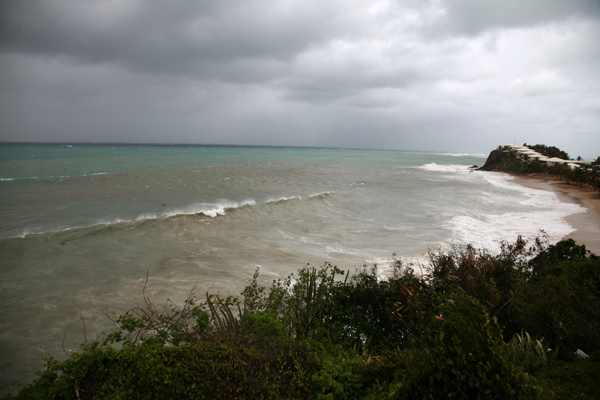
Few things create as much emotion and nervous tension during the summer months as the massive storms we call hurricanes. The word originated from either the ancient Mayan storm god, "Hurakan", or from the Carib word "huracn" meaning god of evil. Either way this word has been scaring people for possibly thousands of years. In recent times science has given us a better understanding of how they form and most importantly how to forecast their strength and track as they come across from Africa. "Hurricane Season" is between June and November with the middle of August to the Middle of September being most active.

A hurricane is a low pressure storm with winds of above 74 mph close to the low pressure center. Hurricanes are classed in categories from 1 to 5 with a cat 1 storm having sustained winds of above 74 mph and a cat 5 having sustained winds of above 155 mph. There are so many variables coming together which scientists are still leaning about that create the necessary conditions for a hurricane to form. All summer long small rain storms make the journey from the West Coast of Africa traveling due west across to the Caribbean.They can give us the occasional rainy day, but for the most part the summer has lovely weather. These "tropical waves" pass through about once a week, and some bring little or no rain at all with just a tiny surge in trade winds. Some have a low enough pressure and strong enough winds and associated rain storms or squalls that they become upgraded to "tropical depressions". Tropical Depressions have winds between 25 and 38 mph. With the right conditions they can strengthen into a "Tropical Storm" and this named system is usually a tighter group of squalls and thunderstorms that are spinning. Tropical Storms must have a sustained wind speed of above 39 mph near the center. Again if conditions are right they can strengthen into a Hurricane. Remember that this would mean there's sustained winds of above 74 mph.

I keep mentioning that ideal conditions are needed and while some are extremely complex, others are not so technical. Almost all of these storms form over the sea, and the sea surface temperature must be above 80 degrees. These warm waters mean there is enough water being evaporated into the atmosphere that thunderstorms are kept alive with the associated energy. Another factor that needed for a storm to form or remain powerful is a light jet stream. Strong jet stream or upper level winds mean the associated wind shear will attack the tops of the thunderstorms breaking them apart. When the jet stream isn't strong and the water temperatures are high, the weather people start paying attention. There are many more variables that need to line up in order for a simple Tropical Wave to develop on its way along the chain towards a hurricane, and because of this the Atlantic only sees about 6 hurricanes a year.
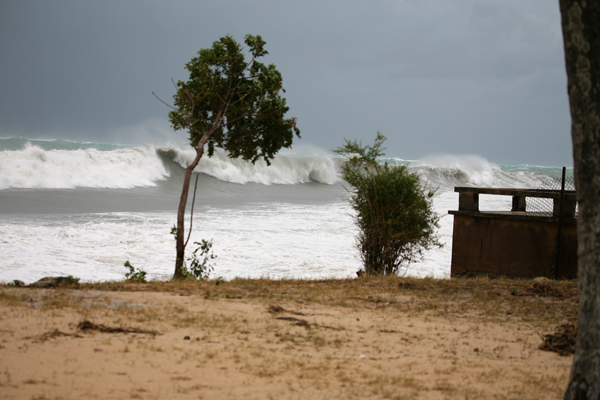
Six sounds bad enough but remember that many hurricanes start and finish in the Atlantic without ever making landfall. Several do make landfall but hurricane force winds usually don't go further than 50 miles from the center which means that if a hurricane goes over Dominica 100 miles to our South it may not give us any hurricane conditions at all. In fact the chances of being hit are so low that records show that in the past 60 years Antigua has had only 6 direct hits. One other thing to remember is that a hurricane is usually averaging about 12mph as it tracks north west in the vicinity of the Caribbean which means that even if it does hit an island the conditions are only felt for a day or less on average. Six days of hurricane conditions in 60 years are not that bad, but you never know which year will be the one when that storm comes your way. The rule of thumb is that during hurricane season you must prepare for the worst and hope for the best. For reports and forecasts from people on the ground here in Antigua visit www.stormcarib.com or search for "antigua weather" on facebook.
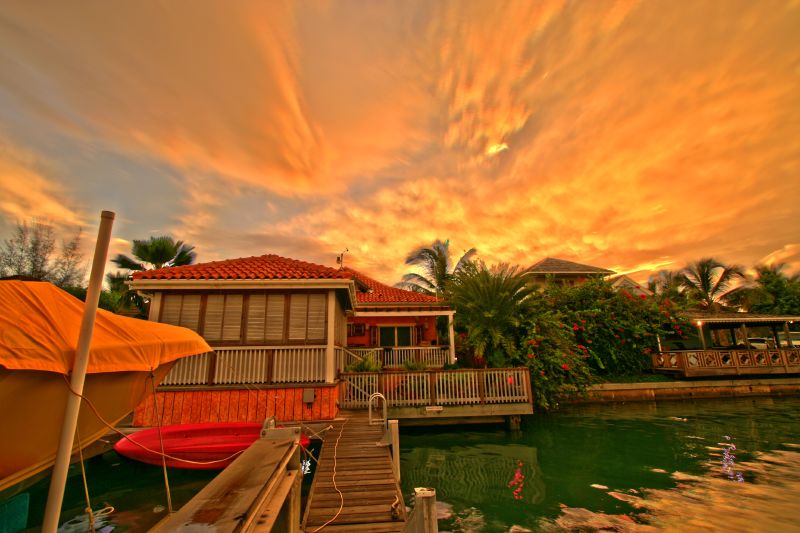

Few things create as much emotion and nervous tension during the summer months as the massive storms we call hurricanes. The word originated from either the ancient Mayan storm god, "Hurakan", or from the Carib word "huracn" meaning god of evil. Either way this word has been scaring people for possibly thousands of years. In recent times science has given us a better understanding of how they form and most importantly how to forecast their strength and track as they come across from Africa. "Hurricane Season" is between June and November with the middle of August to the Middle of September being most active.

A hurricane is a low pressure storm with winds of above 74 mph close to the low pressure center. Hurricanes are classed in categories from 1 to 5 with a cat 1 storm having sustained winds of above 74 mph and a cat 5 having sustained winds of above 155 mph. There are so many variables coming together which scientists are still leaning about that create the necessary conditions for a hurricane to form. All summer long small rain storms make the journey from the West Coast of Africa traveling due west across to the Caribbean.They can give us the occasional rainy day, but for the most part the summer has lovely weather. These "tropical waves" pass through about once a week, and some bring little or no rain at all with just a tiny surge in trade winds. Some have a low enough pressure and strong enough winds and associated rain storms or squalls that they become upgraded to "tropical depressions". Tropical Depressions have winds between 25 and 38 mph. With the right conditions they can strengthen into a "Tropical Storm" and this named system is usually a tighter group of squalls and thunderstorms that are spinning. Tropical Storms must have a sustained wind speed of above 39 mph near the center. Again if conditions are right they can strengthen into a Hurricane. Remember that this would mean there's sustained winds of above 74 mph.

I keep mentioning that ideal conditions are needed and while some are extremely complex, others are not so technical. Almost all of these storms form over the sea, and the sea surface temperature must be above 80 degrees. These warm waters mean there is enough water being evaporated into the atmosphere that thunderstorms are kept alive with the associated energy. Another factor that needed for a storm to form or remain powerful is a light jet stream. Strong jet stream or upper level winds mean the associated wind shear will attack the tops of the thunderstorms breaking them apart. When the jet stream isn't strong and the water temperatures are high, the weather people start paying attention. There are many more variables that need to line up in order for a simple Tropical Wave to develop on its way along the chain towards a hurricane, and because of this the Atlantic only sees about 6 hurricanes a year.

Six sounds bad enough but remember that many hurricanes start and finish in the Atlantic without ever making landfall. Several do make landfall but hurricane force winds usually don't go further than 50 miles from the center which means that if a hurricane goes over Dominica 100 miles to our South it may not give us any hurricane conditions at all. In fact the chances of being hit are so low that records show that in the past 60 years Antigua has had only 6 direct hits. One other thing to remember is that a hurricane is usually averaging about 12mph as it tracks north west in the vicinity of the Caribbean which means that even if it does hit an island the conditions are only felt for a day or less on average. Six days of hurricane conditions in 60 years are not that bad, but you never know which year will be the one when that storm comes your way. The rule of thumb is that during hurricane season you must prepare for the worst and hope for the best. For reports and forecasts from people on the ground here in Antigua visit www.stormcarib.com or search for "antigua weather" on facebook.

Tuesday, August 16, 2011
Some videos on Marine Protected Areas
In Antigua and Barbuda our government has created several MPAs (Marine Protected Areas). Click here to read more about what MPAs are.
Although we have MPAs on paper here, not much has been done by the Government of Antigua and Barbuda to make these "protected" in any way. I go around Antigua and Barbuda by boat every week and I have not seen anything suggesting that we have a MPA other than moorings that have recently been set in sandy areas within NEMMA. NEMMA is the an amazing "paper" MPA here in Antigua which could be an example to the rest of the Caribbean and notable world wide, but the Government here have failed to go from the paper side of the park to the reality of a managed Marine Protected Area. It is my feeling that they don't see the real connection between a properly managed MPA and a healthy fishery, a healthy tourism plant and by extension a healthy economy. Enough about our NEMMA and other MPAs here. Enjoy the videos showing other MPAs.
This TED talk on MPAs is an interesting one. Click here if you would like more info on the talk after you check the video.
An interesting video about how a politician took action to help create an MPA:
A long but interesting video on how MPAs work:
A video showing a properly managed MPA funded by some of the same money our NEMMA received. St. Vincent and Grenadines:
The famous Chagos MPA. Click here for more info:
Although we have MPAs on paper here, not much has been done by the Government of Antigua and Barbuda to make these "protected" in any way. I go around Antigua and Barbuda by boat every week and I have not seen anything suggesting that we have a MPA other than moorings that have recently been set in sandy areas within NEMMA. NEMMA is the an amazing "paper" MPA here in Antigua which could be an example to the rest of the Caribbean and notable world wide, but the Government here have failed to go from the paper side of the park to the reality of a managed Marine Protected Area. It is my feeling that they don't see the real connection between a properly managed MPA and a healthy fishery, a healthy tourism plant and by extension a healthy economy. Enough about our NEMMA and other MPAs here. Enjoy the videos showing other MPAs.
This TED talk on MPAs is an interesting one. Click here if you would like more info on the talk after you check the video.
An interesting video about how a politician took action to help create an MPA:
A long but interesting video on how MPAs work:
A video showing a properly managed MPA funded by some of the same money our NEMMA received. St. Vincent and Grenadines:
The famous Chagos MPA. Click here for more info:
Monday, August 15, 2011
Adventure Antigua's top boss featured on stinging Carib Arena article.
Wow, i am not sure I would have use the title they used, but if you didn't want to see exactly what i said in the video posted here a few days ago and also shown in the link below, then you can read the summary which was featured on their front page. I am sure the comments will not be nice and people will generally not like to hear these things about Antigua, but anyone who doesn't think I am talking the truth should come out with us for a week on the water. They will see the glaring lack of governance. Read the article here:
http://caribarena.com/antigua/environment/environment/98143-environmental-agencies-labelled-useless.html
http://caribarena.com/antigua/environment/environment/98143-environmental-agencies-labelled-useless.html
Saturday, August 13, 2011
talking marine issues on Caribarena Tv
I was invited to come and speak with Colin Sampson on Caribarena Tv about marine issues recently. Colin gobbles up any info to do with environmental issues here in Antigua and is quite well aware of the many problems that we face out there. Anyway, as usual, I ranted a bit too much. I guess you can hear how frustrated i am with all of this. Anyway, while Caribarena seems to be the leader in online news and other related media, they are still working on some of the technical issues. If you would like to listen to the discussion between me and Colin, then drag the video player over to minute 37.20 or about there. It's a long discussion and goes up until 1:51.
Watch live streaming video from caribarena at livestream.com
Friday, August 12, 2011
A UK tax that hurts its former colonies.
As if we didn't have enough to worry about in the Caribbean, the UK is hurting our fragile tourism plants with a totally uncaring tax. When I hear some people speak about getting Europe to consider reparations I don't actually agree with them, but to be honest I do feel that we here in the Caribbean (black, white, or other...) have been left in a very bad situation by the former colonists. Very little in the way of resources and no proper educational framework have left us vulnerable to all sorts of threats and internal problems. Tourism is all we have to ply, and if the UK damages it with this tax then I don't know what we will end up with. This great documentary shows what it is about. If you are coming on holiday from the UK then you should have a look. Appeal to your political leaders that they need to change this thing.
Thursday, August 11, 2011
sargassum come ashore in unprecedented amounts
The Sargasso Sea is an area in the Northern Atlantic Ocean in between the important Ocean currents as seen in the old map below.
I explained these currents in detail in one of my most popular blogs on flotsam and jetsam. You can see that one by clicking here. Read more about the weed here in this link and here in this interesting website. This very important sea of floating weed supports a massive habitat and at this time of the year the little turtle hatchlings are usually swimming out into the currents to try to find protection and food within the weeds. What is usually something that helps the turtles is now something that is hurting them. We had months of unusual south currents and many of us who were fishing in May and June complained about these currents. It seems as though they hit the Sargasso Sea at a strange angle possibly pushing some of the weed away from what is normally a current free area within the north Atlantic gyre. Its as if - in a swirl - masses of sargassum broke off and probably went north and east into the currents which now have brought the weeds back across from Africa into the Caribbean. People from Tobago to Hispaniola are complaining about masses of weeds. This photo below taken by a friend shows what is normally a nice little windward bay on the Eastern side of Antigua. As you can see, the dock is now surrounded by sargassum.
Here in another photo you can see a bay not too far from the one above. This is an areal shot taken by "bugpilot":
Here is photo taken from way above which shows two massive clumps of the weed just east of the islands. I estimate these two patches to be about the size of a football field. There would be so many fish, crabs, shrimp and birds feeding below. It would all come to an end as it washes up on a beach though.
That wouldn't be the only problem either. As the weeds block out the sunlight on that bay above, many other life forms may perish. And then there is the decay. This is like nothing we have seen in my lifetime and it seems that there is still more weed floating across.
It's important to understand that this only effects the windward beaches of any of these islands.
EDIT Friday 12th. Here is more info that points to the direction that it's coming from and suggesting that we are to see more of it. Click here.
I explained these currents in detail in one of my most popular blogs on flotsam and jetsam. You can see that one by clicking here. Read more about the weed here in this link and here in this interesting website. This very important sea of floating weed supports a massive habitat and at this time of the year the little turtle hatchlings are usually swimming out into the currents to try to find protection and food within the weeds. What is usually something that helps the turtles is now something that is hurting them. We had months of unusual south currents and many of us who were fishing in May and June complained about these currents. It seems as though they hit the Sargasso Sea at a strange angle possibly pushing some of the weed away from what is normally a current free area within the north Atlantic gyre. Its as if - in a swirl - masses of sargassum broke off and probably went north and east into the currents which now have brought the weeds back across from Africa into the Caribbean. People from Tobago to Hispaniola are complaining about masses of weeds. This photo below taken by a friend shows what is normally a nice little windward bay on the Eastern side of Antigua. As you can see, the dock is now surrounded by sargassum.
Here in another photo you can see a bay not too far from the one above. This is an areal shot taken by "bugpilot":
Here is photo taken from way above which shows two massive clumps of the weed just east of the islands. I estimate these two patches to be about the size of a football field. There would be so many fish, crabs, shrimp and birds feeding below. It would all come to an end as it washes up on a beach though.
That wouldn't be the only problem either. As the weeds block out the sunlight on that bay above, many other life forms may perish. And then there is the decay. This is like nothing we have seen in my lifetime and it seems that there is still more weed floating across.
It's important to understand that this only effects the windward beaches of any of these islands.
EDIT Friday 12th. Here is more info that points to the direction that it's coming from and suggesting that we are to see more of it. Click here.
Wednesday, August 10, 2011
great review of xtreme from antiguaforums.com
Amazing time on the Extreme Circumnav tour
by parrothead82 » Tue Aug 09, 2011 4:14 pm
On July 26th 2011-we did the Extreme Circumnav tour with Adventure Antigua-All I can say is WOW!!!!!! We did the Eco tour July 2011-had a good time-this tour was GREAT!!! Each tour we do just gets better and better!!!!! Every aspect of this trip was done with ease. From booking on line and asking questions of Nell and staff to the actual tour. The crew this time was JD, Chris and Serge-we had Chris on last years tour-hes so nice and funny. Serge and JD are quiet and if you listen to them they are soo funny. We were picked up first and dropped of last so we got to chat with them all-it was an extra perk-well we felt it was-they are great to be around. After the tour you feel like they are your longtime friends and could hang out with them all day. The boat is very easy to get on and off, very clean. Our tour was full yet the boat never felt crowded!!! Lunch was very tasty and plenty of it. Sting ray city is truly amazing!!! Chris was great-he let me hold on to him as the sting rays were all around us. I thought I was brave but once they swam on you it kinda freaked me out alittle-it was very reassuring having Chris there and Serge -encouraging at all times. They always checked to make sure everyone was doing ok and gave pointers while snorkling. All and All a PERFECT Day!!!! Great Job to all at Adventure Antigua!!!!! Eli you have a great group of people on your crew!!!! Hope to do another trip with you next year-hopefully go sailing-once again Thank you for a great time!!!!
Parrothead82
by parrothead82 » Tue Aug 09, 2011 4:14 pm
On July 26th 2011-we did the Extreme Circumnav tour with Adventure Antigua-All I can say is WOW!!!!!! We did the Eco tour July 2011-had a good time-this tour was GREAT!!! Each tour we do just gets better and better!!!!! Every aspect of this trip was done with ease. From booking on line and asking questions of Nell and staff to the actual tour. The crew this time was JD, Chris and Serge-we had Chris on last years tour-hes so nice and funny. Serge and JD are quiet and if you listen to them they are soo funny. We were picked up first and dropped of last so we got to chat with them all-it was an extra perk-well we felt it was-they are great to be around. After the tour you feel like they are your longtime friends and could hang out with them all day. The boat is very easy to get on and off, very clean. Our tour was full yet the boat never felt crowded!!! Lunch was very tasty and plenty of it. Sting ray city is truly amazing!!! Chris was great-he let me hold on to him as the sting rays were all around us. I thought I was brave but once they swam on you it kinda freaked me out alittle-it was very reassuring having Chris there and Serge -encouraging at all times. They always checked to make sure everyone was doing ok and gave pointers while snorkling. All and All a PERFECT Day!!!! Great Job to all at Adventure Antigua!!!!! Eli you have a great group of people on your crew!!!! Hope to do another trip with you next year-hopefully go sailing-once again Thank you for a great time!!!!
Parrothead82
Friday, August 05, 2011
Our oldest and most famous tour gets great reviews again this week.
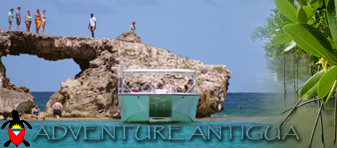
We have been getting some great trip reports and reviews on Tripadvisor recently. This is the latest one and is about our Eco Tour.
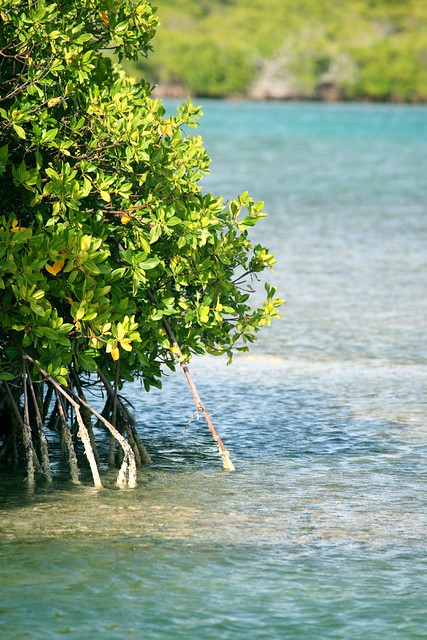
“Unbelievably wonderful day...”
5 of 5 stars Reviewed July 30, 2011 NEW
Had a brilliant time on the Eco tour - have to recommend it highly for the mix of great cruising with informative chat and snorkelling and some mountaineering!
Even my rather aprehensive wife was thrilled with climbing Hells gate and snorkelling over the reefs - she felt safe and comfortable throughout. All this and some amazing Banana bread! Thanks to all for a perfect day

Remember if you would like to read more reviews or write your own CLICK HERE.
Subscribe to:
Comments (Atom)










